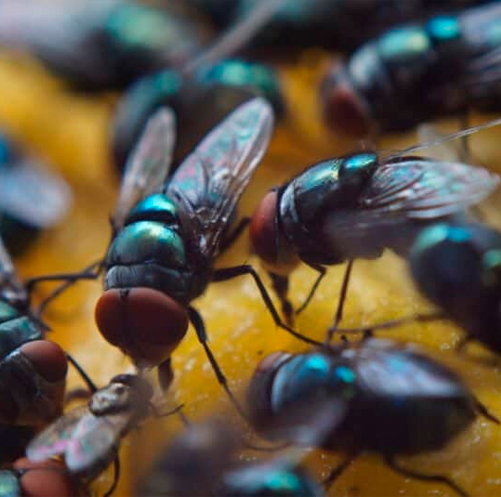The term 'fly', in proper usage, refers to those insects which belong to Order Diptera (di = two, ptera = wings), so they are characterized by the presence of only two wings. Some familiar members of the order are house flies, blowflies, mosquitoes, midges, gnats, hover flies and fruit flies. The order is a large and very successful one, with more than 150,000 species worldwide and just over 7700 species in Australia. Flies have exploited a very wide range of food sources. Various species may be found breeding in vegetation (growing or decayed), in soil (with sufficient organic matter), in decaying organic matter (eg animal excrement, compost, leaf litter, garbage), in water (filtering organic materials, eg immature mosquitoes), in foods for human consumption and, as parasites, in or on other animals. The activities of some flies may be regarded as beneficial (eg pollination, parasitism of certain arthropods). Several species of flies are pests of agricultural and horticultural activities. The overwhelming importance of the group in relation to humans, however, is its medical and veterinary implications for human and animal health. As well, the flying habits of adults frequently cause annoyance, as can the bites of some species, even if disease transmission is not likely.


Structure
Typically, adult flies arc very small to medium sized and have only two wings. In place of hind wings, flies carry a pair of club-shaped balancers called halters. Flies usually have com-pound eyes and a pair of often short antennae. Adult mouth-parts are of the sucking or piercing and sucking type. Larvae are legless and mostly maggot-like in appearance, often tapering towards the head end of the body. Some variations, how-ever, exist (eg the wriggler form of mosquito larvae). Pupae are mostly barrel-shaped and immobile, but again there are several exceptions.
Life cycle
All flies undergo a complete metamorphosis during their development. Eggs, or sometimes live young, are laid in the medium that will serve to feed the larvae. Mosquitoes, then, lay eggs on the surface of water, while house flies and blowflies lay eggs in decaying organic matter (eg animal excrement, animal carcasses). Larvae often feed voraciously. The feeding activity of house fly and blowfly larvae often raises the immediate temperature, facilitating faster development. The majority of dipterous larvae undergo about 4 moults during their larval life. Larval feeding may take a few days or weeks, depending on temperature, food quality, fly species and other factors. At the completion of feeding, the larvae pupate. In aquatic species (eg mosquitoes), this occurs in the same environment in which larval feeding occurred. Many of the terrestrial scavengers (eg house flies, blowflies) tend to crawl away from their larval feeding medium to a drier location (eg the soil adjacent to the animal carcass on which larval feeding occurred). The pupal stage may last for a few days to weeks or even months. Emerging adults usually disperse, on the wing, to find a mate and, in the case of females, an egg-laying site. Flies often overwinter as adults (inactive, hidden and protected) or as larvae that develop very slowly.
Larvicides
The use of insecticides to control fly larvae is not a common practice because:
- Sanitary methods of dealing with breeding sites are often preferred and are the sounder approach;
- Effective applications that will give good contact with the target insects within the breeding medium are difficult to achieve;
- Frequent applications are usually required for any reason-able level of control; and
- It is likely that poor application techniques can, in deal, in g with larvae, lead to the undesirable development of resistance.
Although baits and dusts are used as larvicides, the most common approach is to use water-based surface sprays that Iva the larvae and their feeding sites. Thorough treatment that will contact the larvae is important, and this may require probing or even temporarily moving or disturbing the medium to reach hidden feeding sites. A relatively coarse spray that will not drift away from the target is preferred.
Fly repellents
In Australia, significant sales of personal insect repellents, particularly during the warmer months, indicate the extent of the fly problem. Formulations for personal use are available as roll-ons, lotions and aerosols. Many contain a low concentration of natural pyrethrins — which may be supplemented with chemicals developed specifically fin- their repellent effects (eg diethyl toluamide and N-octyl bicvcloheptene dicarboximide. Well-formulated repellent preparations should give a few hours relief from the immediate presence of flies.
As well, insecticides may be used to repel flies from an oven area. Automatic space-spray systems, commonly employing a non-residual active constituent (such as natural pyrethrins or synthetic pyrethroids), may be set to give a very short burst of insecticide each 30 minutes. High-pressure aerosol systems may be employed for such purposes, as can smaller lower-pressure aerosol dispensers. The system is usually set so that the spray emitted is not sufficient to kill flies but rather has a distinct repellent action. The exact programming of a particular system will he determined by the factors surrounding the particular area. Stich systems have been utilized in outdoor situations with some success (depending, of course, on prevailing weather conditions, attractiveness of odours, size of local fly population and many other factors .